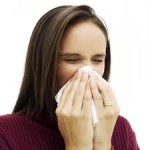 You might feel blue around the winter holidays, or get into a slump after the fun and festivities have ended. Some people have more serious mood changes year after year, lasting throughout the fall and winter when there’s less natural sunlight. What is it about the darkening days that can leave us down in the dumps? And what can we do about it?
You might feel blue around the winter holidays, or get into a slump after the fun and festivities have ended. Some people have more serious mood changes year after year, lasting throughout the fall and winter when there’s less natural sunlight. What is it about the darkening days that can leave us down in the dumps? And what can we do about it?
NIH-funded researchers have been studying the “winter blues” and a more severe type of depression called seasonal affective disorder, or SAD, for more than 3 decades. Still, much remains unknown about these winter-related shifts in mood.
“Winter blues is a general term, not a medical diagnosis. It’s fairly common, and it’s more mild than serious. It usually clears up on its own in a fairly short amount of time,” says Dr. Matthew Rudorfer, a mental health expert at NIH. The so-called winter blues are often linked to something specific, such as stressful holidays or reminders of absent loved ones.
“Seasonal affective disorder, though, is different. It’s a well-defined clinical diagnosis that’s related to the shortening of daylight hours,” says Rudorfer. “It interferes with daily functioning over a significant period of time.” A key feature of SAD is that it follows a regular pattern. It appears each year as the seasons change, and it goes away several months later, usually during spring and summer.
SAD is more common in northern than in southern parts of the United States, where winter days last longer. “In Florida only about 1% of the population is likely to suffer from SAD. But in the northernmost parts of the U.S, about 10% of people in Alaska may be affected,” says Rudorfer. “Some people say that SAD can look like a kind of hibernation. People with SAD tend to be withdrawn, have low energy, oversleep and put on weight. They might crave carbohydrates,” such as cakes, candies and cookies. Without treatment, these symptoms generally last until the days start getting longer.
Shorter days seem to be a main trigger for SAD. Reduced sunlight in fall and winter can disrupt your body’s internal clock, or circadian rhythm. This 24-hour “master clock” responds to cues in your surroundings, especially light and darkness. During the day, your brain sends signals to other parts of the body to help keep you awake and ready for action. At night, a tiny gland in the brain produces a chemical called melatonin, which helps you sleep. Shortened daylight hours in winter can alter this natural rhythm and lead to SAD in certain people.
NIH researchers first recognized the link between light and seasonal depression back in the early 1980s. These scientists pioneered the use of light therapy, which has since become a standard treatment for SAD. “Light therapy is meant to replace the missing daylight hours with an artificial substitute,” says Rudorfer.
In light therapy, patients generally sit in front of a light box every morning for 30 minutes or more, depending on the doctor’s recommendation. The box shines light much brighter than ordinary indoor lighting.
Studies have shown that light therapy relieves SAD symptoms for as much as 70% of patients after a few weeks of treatment. Some improvement can be detected even sooner. “Our research has found that patients report an improvement in depression scores after even the first administration of light,” says Dr. Teodor Postolache, who treats anxiety and mood disorders at the University of Maryland School of Medicine. “Still, a sizable proportion of patients improve but do not fully respond to light treatment alone.”
Once started, light therapy should continue every day well into spring. “Sitting 30 minutes or more in front of a light box every day can put a strain on some schedules,” says Dr. Teodor Postolache of U of Maryland. So some people tend to stop using the light boxes after a while. Other options have been tested, such as light-emitting visors that allow patients to move around during therapy. “But results with visors for treating SAD haven’t been as promising as hoped,” Postolache says.
Light therapy is usually considered a first line treatment for SAD, but it doesn’t work for everyone. Studies show that certain antidepressant drugs can be effective in many cases of SAD. The antidepressant bupropion (Wellbutrin) has been approved by the U.S. Food and Drug Administration for treating SAD and for preventing winter depression. Doctors sometimes prescribe other antidepressants as well.
Growing evidence suggests that cognitive behavioral therapy (CBT)—a type of talk therapy—can also help patients who have SAD. “For the ‘cognitive’ part of CBT, we work with patients to identify negative self-defeating thoughts they have,” says Dr. Kelly Rohan, a SAD specialist at the University of Vermont. “We try to look objectively at the thought and then reframe it into something that’s more accurate, less negative, and maybe even a little more positive. The ‘behavioral’ part of CBT tries to teach people new behaviors to engage in when they’re feeling depressed, to help them feel better.” A preliminary study by Rohan and colleagues compared CBT to light therapy. Both were found effective at relieving SAD symptoms over 6 weeks in the winter. “We also found that people treated with CBT have less depression and less return of SAD the following winter compared to people who were treated with light therapy,” Rohan says.
If you’re feeling blue this winter, and if the feelings last for several weeks, talk to a health care provider. “It’s true that SAD goes away on its own, but that could take 5 months or more. Five months of every year is a long time to be impaired and suffering,” says Rudorfer. “SAD is generally quite treatable, and the treatment options keep increasing and improving.”
Source: NIH News in Health

 The majority of women who reported experiencing sexual violence, regardless of their sexual orientation, reported that they were victimized by male perpetrators.
The majority of women who reported experiencing sexual violence, regardless of their sexual orientation, reported that they were victimized by male perpetrators. Binge drinking is a major public health concern among American women with nearly 14 million overindulging in alcohol, government researchers said.
Binge drinking is a major public health concern among American women with nearly 14 million overindulging in alcohol, government researchers said. Overactive bladder affects an estimated 33 million Americans, the majority of whom are older women. Two treatments have recently received FDA approval.
Overactive bladder affects an estimated 33 million Americans, the majority of whom are older women. Two treatments have recently received FDA approval. If you're suffering from a cold, the flu, or another virus, there are things you can do to help relieve the symptoms, but taking antibiotics will not help. Antibiotics only treat bacterial infections, such as strep throat. Antibiotic resistance is a serious public health problem that is primarily being caused by the repeated and improper use of antibiotics.
If you're suffering from a cold, the flu, or another virus, there are things you can do to help relieve the symptoms, but taking antibiotics will not help. Antibiotics only treat bacterial infections, such as strep throat. Antibiotic resistance is a serious public health problem that is primarily being caused by the repeated and improper use of antibiotics. Young and middle-age women whose diet included high levels of anthocyanins -- the flavonoids present in red and blue fruits such as strawberries and blueberries -- had a significantly reduced risk for myocardial infarction (MI), a large prospective study found.
Young and middle-age women whose diet included high levels of anthocyanins -- the flavonoids present in red and blue fruits such as strawberries and blueberries -- had a significantly reduced risk for myocardial infarction (MI), a large prospective study found. On January 7, the U by Kotex brand, with the help of Ogilvy and Mather, launched a new campaign titled “Generation Know” aimed at addressing vaginal health myths. The campaign consists of short TV spots, longer more candid online videos, and a website providing a forum for frank and honest vaginal health discussion. A representative of the brand has stated that the campaign is meant to inform and empower young girls and women by allowing them to feel comfortable having conversations about their vaginas.
On January 7, the U by Kotex brand, with the help of Ogilvy and Mather, launched a new campaign titled “Generation Know” aimed at addressing vaginal health myths. The campaign consists of short TV spots, longer more candid online videos, and a website providing a forum for frank and honest vaginal health discussion. A representative of the brand has stated that the campaign is meant to inform and empower young girls and women by allowing them to feel comfortable having conversations about their vaginas. These days, many new mothers return to the workplace with a briefcase in one hand—and a breast pump kit in the other.
These days, many new mothers return to the workplace with a briefcase in one hand—and a breast pump kit in the other. Mental disorders are the cause of more than 37% of disabilities worldwide, with depression being the leading cause of disability among people aged 15 and older, according to the World Health Organization’s Global Burden of Disease and Risk Factors (2006). Compared to men, women have twice the rate of depression, with a specific risk at puberty, premenstrually, postpartum, and in the perimenopause. A striking 21% (1 of 5) women and 12% of men will have at least one episode of major depressive disorder in their lifetimes.
Mental disorders are the cause of more than 37% of disabilities worldwide, with depression being the leading cause of disability among people aged 15 and older, according to the World Health Organization’s Global Burden of Disease and Risk Factors (2006). Compared to men, women have twice the rate of depression, with a specific risk at puberty, premenstrually, postpartum, and in the perimenopause. A striking 21% (1 of 5) women and 12% of men will have at least one episode of major depressive disorder in their lifetimes.  You might feel blue around the winter holidays, or get into a slump after the fun and festivities have ended. Some people have more serious mood changes year after year, lasting throughout the fall and winter when there’s less natural sunlight. What is it about the darkening days that can leave us down in the dumps? And what can we do about it?
You might feel blue around the winter holidays, or get into a slump after the fun and festivities have ended. Some people have more serious mood changes year after year, lasting throughout the fall and winter when there’s less natural sunlight. What is it about the darkening days that can leave us down in the dumps? And what can we do about it?